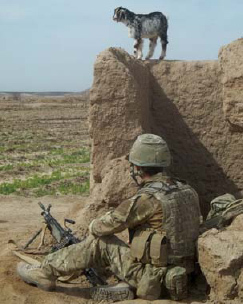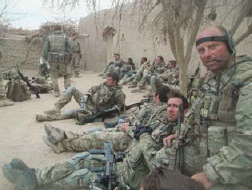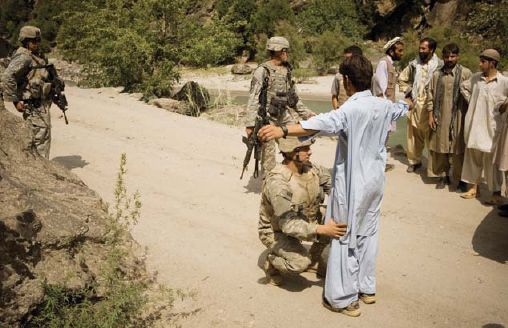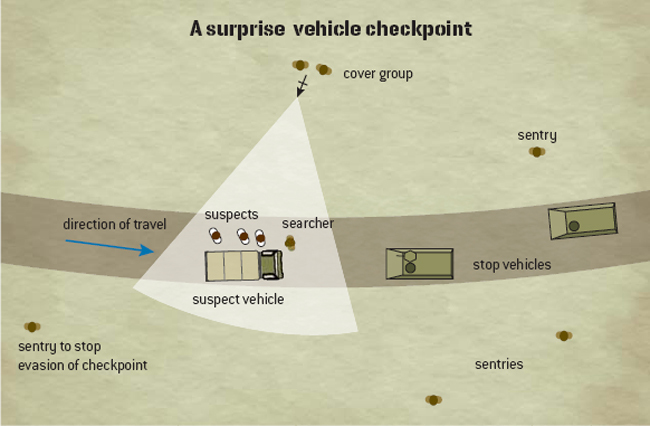Permanent pedestrian checkpoints: When manning the access point to a building or area you know you are looking for a needle in a haystack and that most likely you will not find anything. Boredom and complacency are your enemies here as the cunning insurgent will know when you have been on duty for hours or your tour of duty has run for months. This is when he – or she – will strike.
What equipment you will be issued with to do the searching will depend on the circumstances and the priority of the target. Hopefully you will be issued with sniffer, electronic metal detectors or X-ray machines. Failing this you will have to make do with body searches. The important thing is that you check every person who comes through your gate. The reason for this is quite simple: by checking 1 in 3 or 1 in 10 people you make it risky for the insurgents to send in material. But not risky enough to stop them. Why would they care about getting one courier caught when they are prepared to blow themselves up? No, given the choice, you must check every person who comes to the gate and make sure you catch anyone who turns and does a runner. This makes the checkpoint an efficient deterrent and keeps both you and the secure area safe.

A lone sentry with a machine gun stares at empty landscape with just a small goat for company, Afghanistan 2010. (Photo courtesy Tom Blakey)

The rest of the Parachute Regiment patrol take a well earned break. (Photo courtesy Tom Blakey)
In some situations we are told it is impractical to check everyone owing to the volume of people. This is both dangerous and a waste of time as someone with a bomb will be sent to take the risk. But we all have to follow orders so be aware that a terrorist is not going to look like a shifty bomb-thrower. Rather, the most ordinary of characters. Make your selection for searching accordingly.
I suggest a random selection of prospects to search as a terrorist group testing your defences will observe your technique for some time before sending in their courier. If you don’t search pregnant women, guess who will be carrying the bomb?
Another trick used by the terrorist is to send suspicious looking characters through immediately before the courier. This way you stop the suspicious person and are occupied when the courier carries their bomb through. Look carefully at the people following anyone strange-looking.
Permanent vehicle checkpoints: The three things about vehicles which make them dangerous to you are:
Without using the boot/trunk, bonnet/hood or passenger compartment of the vehicle, you can still pack a huge charge out of sight. This means that a quick search of these places is not enough. Favourites spots are the spare wheel and the spaces inside the upholstery and bodywork. An unpleasant cargo such as animal dung is a good place to hide a bomb too.
In my opinion it is vital to have sniffer technology of some kind when searching vehicles for weapons or explosives. A dog or machine which can detect explosives and gun-oil/cordite makes life simpler, safer and allows you to search much quicker. Therefore you can search more vehicles and catch more insurgents.
Because a vehicle can be carrying hundreds of pounds of explosive it can do damage from a great distance. Including damage to you if you are not careful. See the section on vehicle suicide bombs.

US Military Police search an Afghan local for weapons at a routine checkpoint, near the perimeter of Camp Keating in Afghanistan, September, 2006. (Corbis)
Mobile Checkpoints: The purpose of a mobile checkpoint is to capture explosives, weapons and known insurgents in transit as they move from place to place about their business: a temporary checkpoint can be established by either foot or vehicle-borne soldiers but if the soldiers are in vehicles then they can cover a lot more area and, depending on the circumstances, either deny movement to insurgents over a wider ground or catch more of them. The idea is that you are driving along and suddenly stop and form a checkpoint formation – or you leap out of the bushes and begin stopping vehicles.
When you are doing mobile vehicle checkpoints on roads you may turn up all sorts of things and people. A terrorist organization takes a lot of supplying and they have to move weapons and people just like we do. If you think about it with a surprise checkpoint you are much more likely to catch wanted people, explosives and weapons in transit than vehicle bombs primed for use. This is a good thing. Mobile checkpoints are an excellent counter-insurgency tool and can make life very difficult indeed for the insurgent organization if they are done carefully and at random.

I have done countless thousands of mobile checkpoints – many of them with the IRA as the target and I learnt a lot from dealing with them. One lesson was not to underestimate what a member of the public can do when they hate you. On a checkpoint where we had Land Rovers blocking the road one of our men made the mistake of standing in front of the heavy bumpers/fenders. A suspect vehicle came up at moderate speed and ran ‘accidentally’ into the Land Rover – severing the soldier’s legs. The civilian driver claimed it was an accident and got away with it. The soldier was crippled for life. Don’t make that mistake yourself.
Often the drivers of insurgent courier vehicles – which are the ones you want to catch – are highly trained. In Ireland I have seen a car do a hand-break turn in its own length on a tiny country lane immediately in front of our mobile checkpoint. Very impressive. It sped away and our rules of engagement did not allow us to fire as we were not at risk so the occupants escaped. If you are not allowed to use fire to stop vehicles a spiked chain works well. Attach the chain to a piece of rope which you lay across the road in such a way that the chain can be dragged out to block vehicles escaping by bursting tyres. Always try to place men well down the road both ways to catch people trying to avoid your checkpoint.
One of the main advantages of mobile vehicle checkpoints is that they are not expected by the courier vehicles. A warning to the driver by signal or mobile phone cancels out this benefit. Because the insurgents know how useful they are to our side, they may have the locals briefed to try to warn the people we are looking for when they see a checkpoint. This means that in an area where the locals support the insurgents you will not only have to move regularly but also watch out for mobs gathering, snipers and sometimes full-blown attacks. Sentries should look ‘out’ as well as ‘in’ and beware the efforts of the locals to distract them. On one VCP in the sticks of Northern Ireland a couple of girls did a striptease for us in an upstairs window to take our mind off the job. I suppose it did that.
A few minutes in one place can often be enough to alert the enemy to your presence. The first vehicle you stop may well get on the phone to their local leader and set anything in motion. A bomb for instance. Certainly they will stop the traffic movements you want to catch. Therefore limit your stay to a few minutes at each position. Where the traffic is quiet, start the clock after being seen by a local or stopping your first vehicle. You can sit there all night if no one knows you are there. Mobile checkpoints are a pain for you so make the insurgent suffer too.